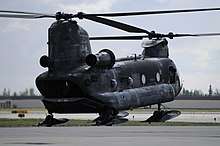Fort Wainwright
Fort Wainwright is a United States Army post in Fairbanks, a city in the U.S. state of Alaska. It is part of the Fairbanks North Star Borough and the coterminous Fairbanks Metropolitan Statistical Area. Although Alaska is within the Continental U.S., Fort Wainwright is considered an overseas tour for soldiers and family members may need to be included in PCS orders to accompany soldiers.[1] The military estimates that the installation serves approximately 7,000 Soldiers and 6,500 Family Members, 2,400 Civilians and Contractors and 7,800 Retirees and Veterans. Since 1978 Fort Wainwright has been investigating and cleaning up soil and water contamination from a landfill and drum burial site, fuel terminal, coal storage yard/fire training pits, open detonation area and underground storage tanks. It was Superfund-listed in 1990.
| Fort Wainwright | |
|---|---|
| Fairbanks, Alaska | |
 U.S. 25th Infantry Division Shoulder Insignia | |
| Type | Army post |
| Site information | |
| Controlled by | U.S. Army |
| Site history | |
| Built | 1941 (as Ladd Field) |
| In use | 1941–present |
| Garrison information | |
| Garrison | US Army Alaska |
History

What is now Fort Wainwright was first established in 1939 by the U.S. Army Air Corps as Ladd Field. In 1947 it was transferred to the newly established U.S. Air Force and renamed Ladd Air Force Base, serving as a cold weather station to test aircraft under arctic conditions. In 1961 it was transferred to the Army and redesignated Fort Wainwright in honor of World War II general Jonathan Wainwright. From 1963 to 1972 it was home to the 171st Infantry Brigade, mechanized until 1969, then light. During that time, the 172nd Infantry Brigade was at Fort Richardson, in Anchorage. From 1986 to 1998 Fort Wainwright was the home of the 6th Infantry Division (Light), and served as the division's headquarters from 1990 to 1994. From 1998 to 2006, it was home to the 172nd Infantry Brigade, which was reorganized in 2003 as the 172nd Stryker Brigade Combat Team (SBCT), part of the U.S. Army's transition program to include six SBCTs. In 2006, the 172nd was re-flagged as the 1st brigade of the 25th Infantry Division.
Fort Wainwright was also the home of Task Force 49, an aviation brigade that provides logistical air support for U.S. Army Alaska, Bassett Army Community Hospital and the Bureau of Land Management's Alaska Fire Service which later transformed to become a part of 16th Combat Aviation Brigade with headquarters at Joint Base Lewis-McChord, Washington in 2010 with duty in Alaska.
Environmental contamination
Since 1978, Fort Wainwright has been participating in the Department of Defense Installation Restoration Program to investigate and clean up contamination. In 1985 and 1986, lead and chromium were detected in monitoring wells at the landfill; in 1987, chromium and tetrahydrofuran were detected in monitoring wells at the proposed housing area, and chromium was detected in soil.[2] About 15,000 people live and work at the fort and obtain drinking water from wells in close proximity to contaminated source areas. The Chena River also runs through the contaminated area of Fort Wainwright.[2]
National Priorities Listing
In August 1990 Fort Wainwright was registered on the national priorities list as a Superfund.[2] In most source areas, groundwater is contaminated with solvents and petroleum products, in a few source areas, with pesticides and/or fuel additives. Soil contains some solvents, waste oil, waste fuel/petroleum products, pesticides, paint residues, fuel tank sludge and polycyclic aromatic hydrocarbons (PAHs). Sediments contain PAHs and low level pesticides.[3] Contaminants on the site also include mercury.
Taku Gardens
To meet the needs of new personnel and their families construction of 128 homes on a 54-acre housing project known as Taku Gardens began in 2005 on the former communications site.[4] In June, 2005 construction workers noticed "stained soil and unusual odors during excavation of a building foundation" and laboratory testing revealed the presence of PCB at concentrations of up to 115,000 mg/kg - Alaska's current clean-up standard is 1 mg/kg.[4] Further testing of the site revealed the presence of volatile and semi-volatile organic compounds, chlorinated compounds including solvents, herbicides, pesticides, dioxins, and "munitions-related compounds" such as nitroaromatics and propellants.[4] Construction was suspended August–September 2005 and continued until end of 2006. A January, 2007 Army audit questioned "the wisdom of building a family housing complex on top of a known 1950s-era military landfill" and concluded that "the situation with the Taku construction project is the direct result of multiple individuals failing to adhere to Army and federal regulations and guidance."[5][6] From 2007 to 2010 drums and debris were excavated, PCB contaminated soil was removed and backfilled, but some fuel and volatile organic compound-contaminated soil and groundwater remains on site.[7]
Construction of the housing project resumed during the summer of 2011. In the intervening years, many housing units between Taku Gardens and the main gate were reconstructed or renovated, with new housing built as well. Immediately northeast of Taku Gardens, Bear Paw was built on a part of the former site of Bassett Army Hospital, while construction of new homes began on the rest of the site in 2011. Immediately northeast of Bear Paw, Denali Village, a much larger development, was constructed between Glass Park and the former billeting. Taku Gardens area, the newer housing across from Bassett Hospital was renamed to Tanana Trails in 2015.
Hangar 6
In June, 2006 civilian construction workers at Aircraft Maintenance Hangar No. 6 – known by the Corps of Engineers to be a designated Hazardous Waste Accumulation point – were overcome by fumes described as "pungent, chalky and metallic tasting" and suffered nausea, headaches and other symptoms. A state health report concluded that "an unknown, volatile chemical likely caused nerve damage to the disabled workers." More than 30 workers were hospitalized and at least 4 have suffered lasting disabilities. The workers initiated a civil suit against the Army which was dismissed because the workers were limited to state workers’ compensation as their only relief.[8][9]
Underground storage fuel tanks
EPA inspections found that from at least 2012 to 2013, Fort Wainwright failed to monitor underground storage tanks regularly, perform leak detection tests, and investigate suspected releases.[10] The Army paid a penalty of nearly $158,700.
Demographics
| Historical population | |||
|---|---|---|---|
| Census | Pop. | %± | |
| 1970 | 9,097 | — | |
Fort Wainwright appeared once on the 1970 U.S. Census as an unincorporated military installation. It was formally annexed into the City of Fairbanks in April 1973.[11] The census listing was an anomaly: the boroughs created by the state under the 1963 Mandatory Borough Act were tasked with providing K-12 public education for their areas. The Greater Anchorage, Fairbanks North Star and Kodiak Island boroughs exempted military installations from their boundaries at the time so that the military could operate their own schools, which included the time period in which the 1970 Census was conducted. The military schools merged with the borough school districts in 1975 during a comprehensive reorganization of Alaska's educational structure.
In the 2010 U.S. Census Fort Wainwright was included in the Badger, Alaska census-designated place (CDP) that also includes small suburbs in the outskirts of Fairbanks and the area around North Pole.[12] The Soldiers and Family Members are very transient but the total population number less so. The military population is a significant part of the Badger population of 19,482 reported in the 2010 Census.
References
- USAG Alaska, Fort Wainwright is considered an overseas tour."Military Installations USAG Alaska, Wainwright". U.S. Department of Defence. Military OneSource. Retrieved 2020-07-11.
- "NPL Site Narrative for Fort Wainwright". US EPA. 30 August 1990. Retrieved 5 July 2014.
- "FORT WAINWRIGHT". US EPA. February 2007. Retrieved 5 July 2014.
- "Fort Wainwright, Taku Gardens (102 Communications Site)". State of Alaska Department for Environmental Conservation. June 2009. Retrieved 2011-03-05.
- "Army knew Alaska base family housing site was toxic". PEER. July 7, 2008. Archived from the original on January 17, 2011. Retrieved 2011-03-05.
- "Taku Housing Construction Project Audit" (PDF). Office of the Staff Judge Advocate, US Army Alaska. January 2007. Archived from the original (PDF) on 2010-12-18. Retrieved 2011-03-05. Hosted by PEER.
- U.S. Army Corps of Engineers (January 2014). "Operable Unit 6, Former Communications Site Record of Decision" (PDF). US ARmy. pp. 188–263. Retrieved 5 July 2014.
- "Chemical caused nerve damage to military base workers". PEER. January 20, 2011. Archived from the original on April 17, 2011. Retrieved 2011-03-05.
- Burke, Jill (January 20, 2011). "Unearthed toxin at Fort Wainwright likely injured workers". Alaska Dispatch. Retrieved 2011-03-05.
- "Fort Wainwright Reduces Water Contamination Risk from Fuel Tanks in EPA Settlement". News release. EPA. 2 July 2014. Retrieved 5 July 2014.
- "Fort Wainwright, 172nd Infantry Brigade, Land Withdrawal: Environmental Impact Statement". 1981.
- Alaska: 2010 - Summary Population and Housing Characteristics"2010 Census of Population and Housing" (PDF). U.S. Department of Commerce - Economics and Statistics Administration. U.S. CENSUS BUREAU - census.gov. 2012-06-30. Retrieved 2020-07-11.
